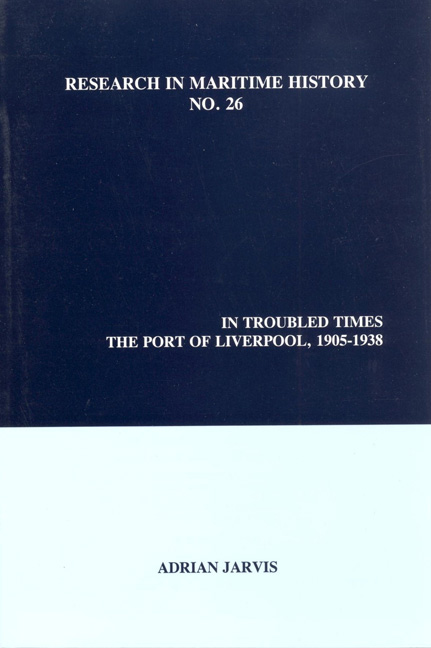Book contents
- Frontmatter
- Table of Contents
- List of Figures
- Foreword and Acknowledgements
- Conversion Factors for Imperial Measurements
- Introduction: The Port of Liverpool in 1905
- Chapter 1 The Port and Its Trade in 1905
- Chapter 2 Gladstone Dock
- Chapter 3 Not Before Time: The Board Keeps its Promise
- Chapter 4 Engineering, Management and Decision-making
- Chapter 5 Making the Customers Happy
- Chapter 6 Sand, Silt and Sewage: The Work of the Board's Dredgers
- Chapter 7 The Provision of Specialist Cargo Facilities
- Chapter 8 Into the Modern World?
- Conclusion: On the Eve of War
- Appendix: Port Efficiency: A Short Methodological Discourse
- A Note on Sources: Abbreviations
- Bibliography
- Index
Appendix: Port Efficiency: A Short Methodological Discourse
- Frontmatter
- Table of Contents
- List of Figures
- Foreword and Acknowledgements
- Conversion Factors for Imperial Measurements
- Introduction: The Port of Liverpool in 1905
- Chapter 1 The Port and Its Trade in 1905
- Chapter 2 Gladstone Dock
- Chapter 3 Not Before Time: The Board Keeps its Promise
- Chapter 4 Engineering, Management and Decision-making
- Chapter 5 Making the Customers Happy
- Chapter 6 Sand, Silt and Sewage: The Work of the Board's Dredgers
- Chapter 7 The Provision of Specialist Cargo Facilities
- Chapter 8 Into the Modern World?
- Conclusion: On the Eve of War
- Appendix: Port Efficiency: A Short Methodological Discourse
- A Note on Sources: Abbreviations
- Bibliography
- Index
Summary
Port Efficiency: A Short Methodological Discourse
Calculations or estimates of port efficiency appear in many places in this book, and they would not do so if the author did not believe that they are of some value in the understanding of port development. Such figures are not a recent construct, as are some which have been calculated by historians since the days of “The New Economic History” of the 1960s. On the contrary, they were often calculated in the nineteenth century for presentation to Parliamentary Select Committees when applying for powers to build, extend or modernise a particular dock or group of docks. That, however, does not necessarily make them trustworthy, or release us from the obligation to use them in an intelligent manner. The fact that “new” figures have been calculated from a normally reliable source such as the Board's Revenue Statements, does not mean that they need not be interrogated just as critically as other sources.
If, for example, one measures efficiency (as the Board often did) in terms of tonnage handled per linear yard of quay, then to make valid comparisons it is essential to know what was being handled and how it was handled at the time in question. Discharge of timber during the period covered in this book differs dramatically from timber discharge in the latter days of sail because the sailing ships moored bow-on to the quay, hence the length of their holds became the notional midship cross-section on the basis of which cargo density was calculated. Their efficiency in terms of tons/yard was higher than that of more modern vessels, but, of course, their efficiency in tons per water acre was less. The use of tonnage per square yard of quay was a less popular yardstick at the time, but that too would show a comparatively low efficiency for a dock in which timber was important because of the large “standing ground” required, to say nothing of the space needed to handle butts up to forty or so (and exceptionally up to seventy) feet long.
Conversely, imported bulk grain was not an especially “good” traffic in terms of revenue per yard, but, standing in silos rarely less than eighty feet high, it looked absolutely superb if assessed in tons per square yard of quay.
- Type
- Chapter
- Information
- In Troubled TimesThe Port of Liverpool, 1905-1938, pp. 211 - 218Publisher: Liverpool University PressPrint publication year: 2003



